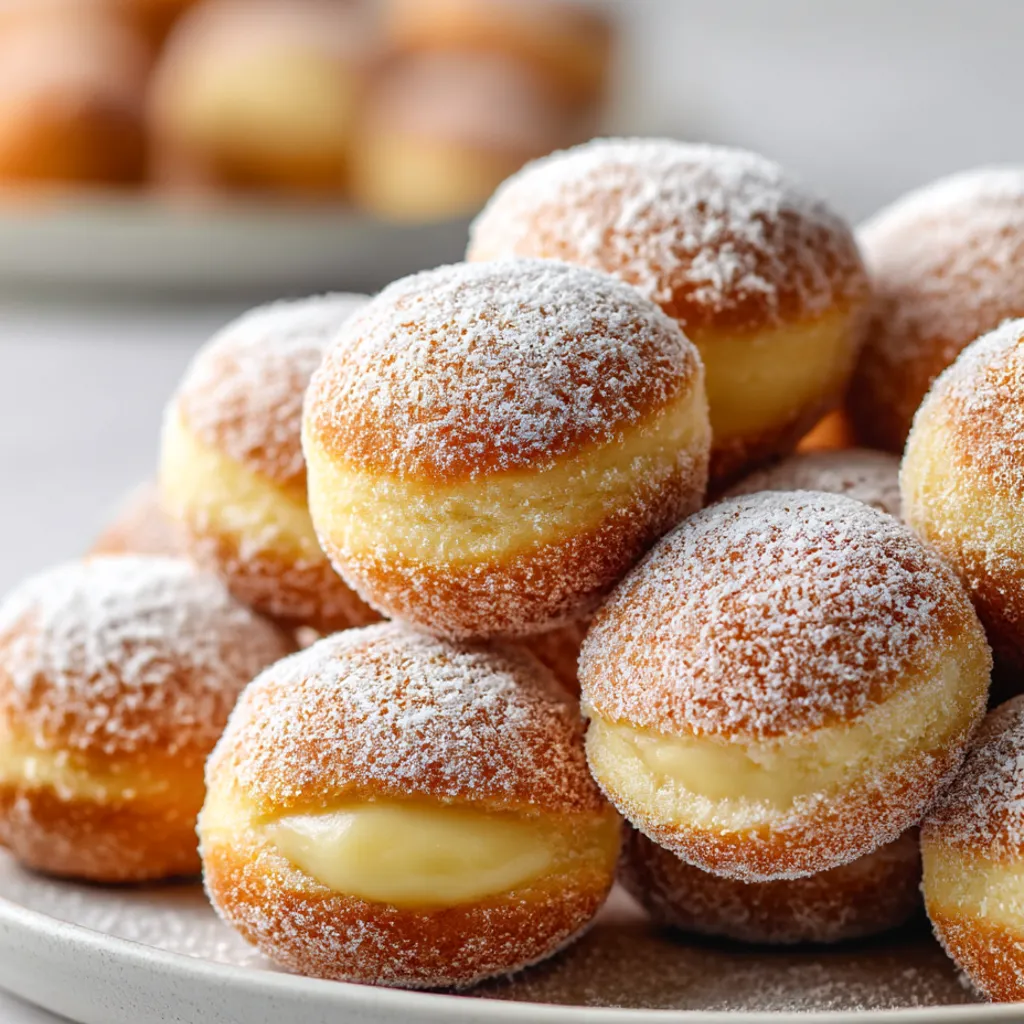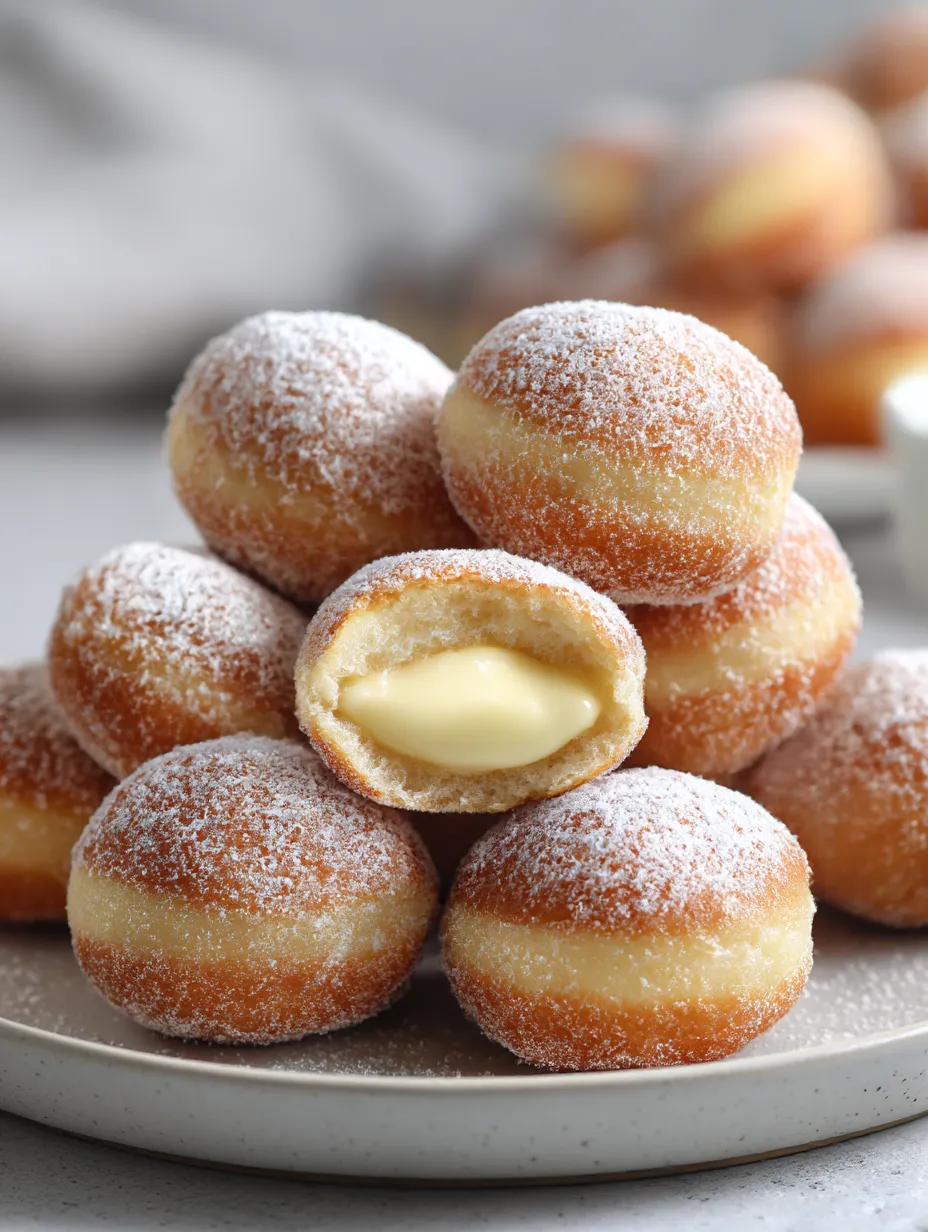 Pin
Pin
Bomboloni are soft pillowy Italian donuts filled with creamy custard or jam and rolled in sugar. Born as a breakfast treat in Italy these are now a family favorite for weekend brunches and celebrations in my kitchen. They turn any morning into a special one.
My first experience making bomboloni was on a Sunday morning with my little niece pressing the donut cutter. This recipe brings out pure joy every single time we fry a new batch.
Ingredients
- Bread flour: gives structure and chew to the donuts Choose a strong flour for best results
- All purpose or 00 flour: lightens the dough and makes it tender If you find Italian 00 flour use it for authentic texture
- Eggs: add richness and help the dough bind together Always use room temperature eggs for smooth mixing
- Softened butter: gives a silky mouthfeel and boosts flavor Look for European style butter if possible
- Granulated sugar: sweetens the dough and helps it brown
- Warm milk: brings the dough together and activates the yeast Use milk just above body temperature but not hot
- Vanilla paste or extract: infuses the dough with lovely aroma Consider using vanilla bean for a luxury touch
- Fast action yeast: is essential for a high rise Make sure your yeast is in-date and active
- Pinch of salt: balances the flavors and enhances sweetness
- Caster or confectioners sugar for rolling: gives a delicate sweet crust over each donut
- Sunflower or vegetable oil: is best for frying because of its light taste and high smoke point
- For the optional pastry cream filling: use egg yolks for richness whole milk for a luxurious custard cornstarch to thicken sugar for gentle sweetness vanilla and lemon zest for classic flavor
Step-by-Step Instructions
- Make the Dough:
- Add bread flour all purpose flour granulated sugar and yeast to your stand mixer bowl Stir for a few seconds to combine the powders evenly so the yeast spreads through the flour
- Mix in the Wet Ingredients:
- Scatter the softened butter in small bits across the flour Now pour in the eggs warm milk vanilla and pinch of salt Start the mixer on low speed to let the butter and liquids slowly hydrate the flour without lumps
- Knead the Dough:
- Knead with the dough hook on low for ten minutes The dough will look sticky at first then should become glossy stretchy and slightly tacky It should not stick much to your finger when pressed Adjust with a sprinkle of flour or a splash of milk if needed
- Shape and First Rise:
- Move the dough onto a clean counter No extra flour is needed if dough is soft but not sticky Knead lightly a few times until it is a smooth even ball Put in a lightly oiled bowl and cover tightly Let it rise for two to three hours in a warm spot until tripled in volume
- Deflate and Second Shaping:
- Gently push down the risen dough to release air Once again shape into a ball Roll with your palms to flatten into a rectangle about half an inch thick
- Cut Dough Circles:
- Using a round cutter or glass about three inches wide press into the dough for neat rounds Collect leftover scraps for a second batch or cut them randomly for rustic bombs
- Second Rise:
- Lay each dough circle on a parchment lined tray Cover with a clean towel or wrap not tight Let rise for one to one and a half hours until puffy and almost triple in size
- Prepare Pastry Cream Filling:
- For filling whisk egg yolks sugar vanilla and lemon zest in a bowl Mix until pale Add cornstarch and blend well Heat milk until almost simmering then slowly whisk into egg mixture Pour everything back into the saucepan Gently cook on low stirring until thick about ten minutes Do not rush or overheat Pour into a bowl with wrap on the surface Let cool fully before filling
- Frying:
- Heat your oil in a deep pot to 170 degrees Celsius Use a thermometer for accuracy Drop dough rounds in carefully using their parchment as helpers Fry a few at a time turning once after about two minutes per side Remove when deep golden Let rest on kitchen towels
- Sugar Coating:
- Toss warm donuts in caster or confectioners sugar so it sticks everywhere for that signature sparkling finish
- Filling the Bomboloni:
- When cool make a slit in the side of each donut with a small knife Wiggle it gently to create room Squeeze your pastry cream or jam in using a piping bag Serve right away and watch everyone smile
 Pin
Pin
My favorite moment is when the sugar hits the hot donut and melts just a little That first bite always brings back memories of eating street food near the sea with my cousins in Tuscany
Storage Tips
To keep bomboloni soft store any leftover donuts in an airtight container at room temperature for one to two days They start to lose that perfect fluffy bite after about thirty six hours Avoid refrigerating as it dries them out For longer storage freeze bomboloni unfilled wrapped tightly in plastic and foil For best results thaw at room temperature and reheat in the oven for five minutes at low heat then fill and sugar coat
Ingredient Substitutions
All purpose flour works well if you cannot find bread flour but your donuts will be a little less chewy For dairy free donuts use a plant based milk and vegan butter Substitute citrus zest for vanilla in the dough if you prefer a brighter flavor For the pastry cream swap cornstarch with flour if needed but cornstarch keeps the filling silkier
Serving Suggestions
Fill each bombolone with different flavors such as raspberry jam Nutella or coffee pastry cream For a festive touch roll in cinnamon sugar or fill with whipped ricotta Serve for brunch with hot coffee or as part of a dessert platter for parties They are always the first to disappear
Cultural Context
Bomboloni are a beloved breakfast pastry across Italy especially on the coast and at local festivals Each region has its own twist from plain sugar dusted rounds to luxurious crema filled versions This recipe gives you a taste of an Italian morning no passport needed
Recipe Questions & Answers
- → What kind of flour works best for these donuts?
Combining strong bread flour with 00 or all-purpose flour gives the dough its structure while keeping it soft and airy when fried.
- → How do you achieve a light, fluffy texture?
The two-stage rising process and gentle kneading ensure the dough becomes airy and pillowy when cooked.
- → What oil should I use for frying?
Use a neutral oil like sunflower or vegetable oil, heating to 170°C (337°F) for even, golden results.
- → Can I prepare the pastry cream ahead of time?
Yes, prepare and cool the pastry cream in advance so it's ready for filling and has the ideal thick, smooth texture.
- → How are the donuts filled after frying?
Once cooled, make a small incision on the side and pipe in cream or your favorite filling for a creamy center.
- → How do I store leftovers for freshness?
Store in an airtight container for up to two days. Though best fresh, they stay soft and tasty if kept covered.